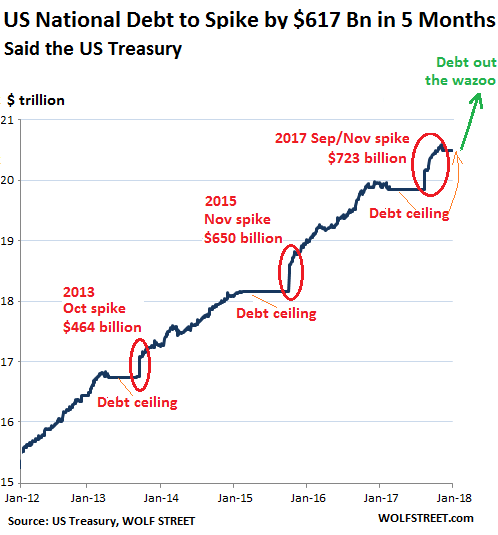Wolf Richter wolfstreet.com, http://www.amazon.com/author/wolfrichter
Just as the Fed accelerates its QE Unwind. Treasuries reacted.
While everyone is trying to figure out how to twist the new tax cut to their advantage and save some money, the US Treasury Department just announced how much net new debt it will have to sell to the public through the second quarter to keep the government afloat: $617 billion.
That’s what the Treasury Department estimates will be the total amount added to publicly traded Treasury securities — or “net privately-held marketable borrowing” — through the end of the second quarter. This will be the net increase in the US debt through the end of Q2. By quarter:
- During Q1, the Treasury expects to increase US public debt by $441 billion. It includes estimates for “lower net cash flows.”
- During Q2 – peak tax seasons when revenues pour into the Treasury – it expects to increase US public debt by $176 billion.
It also “assumes” that with these increases in the debt, it will have a cash balance at the end of June of $360 billion.
So over the next five months, if all goes according to plan, the US gross national debt of $24.5 trillion currently – which includes $14.8 trillion in publicly traded Treasury securities and $5.7 trillion in internally held debt – will surge to about $25.1 trillion.
That’s a 4% jump in just five months. Note the technical jargon-laced description for this (marked in green on the chart):

The flat lines in 2013, 2015, and 2017 are a result of the prior three debt-ceiling fights. Each was followed by an enormous spike when the debt ceiling was lifted or suspended, and when the “extraordinary measures” with which the Treasury keeps the government afloat were reversed. And note the current debt ceiling, the flat line that started in mid-December.
In November, Fitch Ratings said optimistically that, “under a realistic scenario of tax cuts and macro conditions,” the US gross national debt would balloon to 120% of GDP by 2027. The way things are going right now, we won’t have to wait that long.
Back in 2012, gross national debt amounted to 95% of GDP. Before the Financial Crisis, it was at 63% of GDP. At the end of 2017, gross national debt was 106% of GDP!
Over the next six month, the debt will grow by about 4%. Unless a miracle happens very quickly, the debt will likely grow faster over the next five years due to the tax cuts than over the past five years. But over the past five years, the gross national debt already surged nearly 25%, or by $4.1 trillion.
So that’s a lot of borrowing, for an economy that is growing at a decent clip. What will happen when the full force of the tax cut hits US government receipts, or when the next recession appears out of the blue and outlays jump as receipts fall? What will happen to the government’s borrowing needs?
The bond market is barely starting to do the math.
This comes at the precise time when the Fed is unwinding its QE. It’s reducing its pile of Treasury Securities by up to $36 billion during Q1 and by up to $54 billion in Q2. In addition, it will also allow MBS to roll off its balance sheet.
Is the Treasury market already figuring out the answer, given this surge in supply? Will some frazzled folks start buying gold and unload Treasuries? The answer is that new investors need to be lured into the market with higher yields. Which means lower prices. And this will hurt existing investors.
So the Treasury sell-off continues. The 10-year Treasury yield rose today to 2.73%, the highest since April 22, 2014. And the average 30-year fixed-rate mortgage – which follows the benchmark 10-year Treasury yield – was quoted today with a rate for top-tier borrowers of 4.35%, also the highest since 2014.
But folks that were worried about an “inverted yield curve” can relax. It isn’t going to happen. Instead, they might want to worry about the housing market. Read… Um, Is the US Treasury “Yield Curve” Steepening or Flattening?